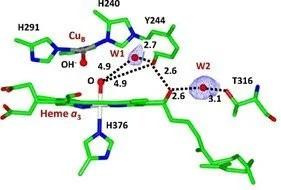Accurate Active Site Structures of Macromolecular Machines
It is estimated that between 20% and 50% of proteins found within an organism contain a metal ion in some form.
Metalloproteins, or metalloenzymes, are critical to nearly all biological processes and as such represent a rich target space for drug development for a wide variety of diseases. High-resolution structural studies of metalloproteins are particularly challenging because the metal centers, especially those that are redox-active, are very susceptible to X-ray-induced photoreduction.
For instance, single-crystal X-ray absorption fine structure (XAFS) measurements have revealed that the Mn4Ca active site of Photosystem-II (PSII), the living machinery responsible for photosynthesis, was entirely reduced from the Mn(III2, IV2) state to the non-physiological Mn(II4) state under similar conditions that would typically be used to determine the crystal structure using synchrotron X-ray sources.
In Serial Femtosecond Crystallography (SFX), the diffraction process happens before atomic rearrangements can occur around the metal center and consequently the SFX methods are particularly advantageous for the determination of catalytically relevant structures of metalloenzymes.
Structures of the highly radiation-sensitive PSII active site in the dark-adapted and multiple intermediate states were determined using data collected at room temperature at LCLS to provide insight into the water splitting in the Mn4Ca cluster.
This work also illustrates the advantages of LCLS to collect a series of structural snapshots at different time points (a molecular movie) to describe the interactions needed for the performance of biological functions.

The technology developments of the SDB Resource will address many challenges faced by crystallographers studying metalloproteins, including verification of correct incorporation and chemical state of the metal of interest, and maintenance of the optimal environment for sample preparation and data collection, especially if the experiment requires anaerobic, low-temperature, or aphotic environments.
Since X-ray diffraction is a limited technique for determining the oxidation state of the metal, the developments of the Resource include several complementary spectroscopic methods, and some run concurrently with the diffraction experiment. These methods will also be made available before LCLS beam time.
Examples:
- Isopenicillin N synthase (Driving Biomedical Project with Jan Kern, Lawrence Berkeley National Laboratory)
- Cytochrome C oxidase (Driving Biomedical Project with Denis Rousseau, Albert Einstein College of Medicine)
